 In this exclusive interview, conductor Paul Mann looks back at Celebrating Jon Lord, the concert event staged at London’s Royal Albert Hall on April 4 this year.
In this exclusive interview, conductor Paul Mann looks back at Celebrating Jon Lord, the concert event staged at London’s Royal Albert Hall on April 4 this year.
Paul offers insight into his work in assisting The Sunflower Jam create a unique musical evening that was a successful celebration of Jon Lord and a life time of his music. This is part 1 of 3.
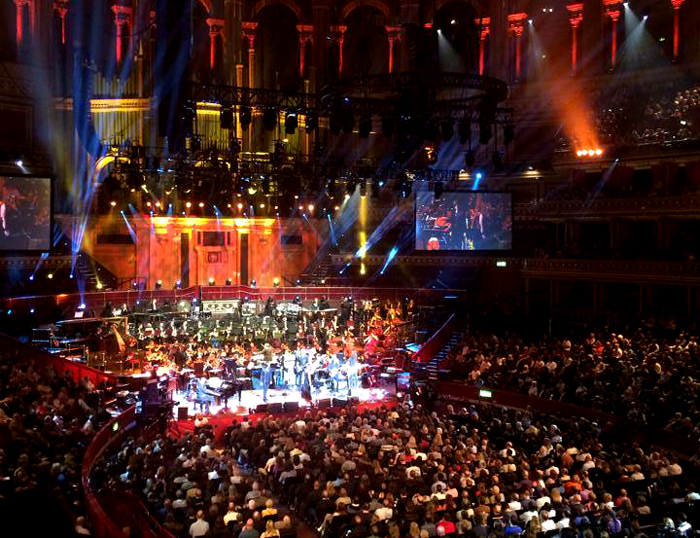
Since Jon passed away, Paul Mann has been working on producing updated editions of all of Jon’s musical works. This work made him an integral partner for The Sunflower Jam when the preparations for Celebrating Jon Lord began.
Apart from adding his input to the setlist of Jon’s music to be performed at the concert, one of Paul’s first ideas was to add orchestral arrangements to two tracks off Deep Purple’s most recent album, NOW What?!
Read here about the initial meetings to get the concert plans off the ground, the hectic rehearsals, and much more.
by Rasmus Heide
Looking back at Celebrating Jon Lord at Royal Albert Hall on April 4, would you agree that this was much more than a regular evening of music?
– Yes, there was a very strong element of catharsis about it for very many people – a way to deal with their feelings about losing Jon. With all of that emotion together in one room, even (or perhaps especially) one as big as the Albert Hall, something special was bound to happen. And that incredibly moving appearance of [Jon’s wife] Vicky onstage with Ian [Paice] by her side – it was so brave of her to do that – this set the emotional tone of the whole evening.
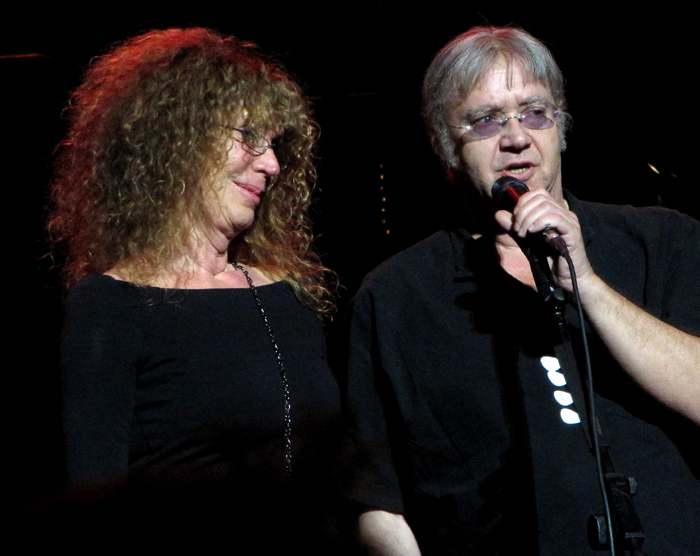
If you go back to that evening in your mind now, what do you remember going through your head?
– I suppose speaking purely straightforwardly, a huge amount of concentration on the task in hand. That was a lot of traffic to control! But beforehand, in between chatting to Bob Harris (with whom I was sharing a dressing room), changing my suit, and doing my bit of stuff for the documentary cameras, there wasn’t a lot of time to sit around and think about things. For several days afterwards I felt somewhat numb, as if the whole thing had happened to someone else.
– There are certain touchstone moments in the music we played – for example in the Durham Concerto excerpt; it’s after the second tune in the pipes, where the two soloists have that tune in octaves – somehow Jon is really ‘present’ in that music.
– Little moments like that where the frisson was especially strong – I felt a certain prickling in the back of my eyes a few times in the rehearsal, but not at the concert. The conductor is there to move the audience, not himself!
Jon told me that he had no recollections from the actual performance of the Concerto at the Royal Albert Hall in 1969. His memory kicked in when he lifted his head after the final chord and the crowd erupted. Do you have the same experience?
– Yes, I can relate to that. Perhaps when I see the video of the concert I might start to remember things more clearly.
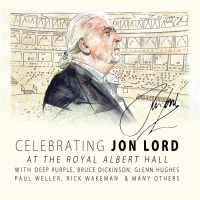
We’ll get back to the video and the concert, but let’s start at the beginning. Could you tell me how the Celebrating Jon Lord project started? Who was at the initial meetings, etc?
– We first met at a lunch, very generously hosted by the Paice and Lord families at a pub near Henley early in the spring of 2013. The first thing was to begin to talk about what sort of form the concert could take, and where it might be.
– Obviously we knew it couldn’t be a proper tribute to Jon without an orchestra, so I threw in right at the start that we’d need a full-sized symphony orchestra of 90 players, which made everyone else order another drink.
– But once the shock wore off, I know that the Sunflower Jam office and Jon’s tireless manager Tarquin Gotch all put in a huge amount of work behind the scenes to crunch the necessary numbers to make the orchestra possible.
– After a lot of general talk at that first meeting, we reconvened a few weeks later in the Paice family garden, this time with a slightly larger group, which included Rick Wakeman and Bruce Dickinson, and it all started to take shape a bit more.

Wasn’t the initial plan to have the concert in the Fall of 2013?
– There was some talk of that, but among other things the Albert Hall wasn’t free, and it was worth holding out for that. As Leonard Bernstein once said, “to achieve something all you need is a plan and not quite enough time.” So April 2014 it became.
– As far as securing an orchestra, we knew that, with fees for recording and filming, as well as the rehearsal time we needed, the cost of one of the major London orchestras was beyond us. So various solutions were mentioned, and it was Rick Wakeman who suggested the Orion Orchestra, with whom he’d worked before and been very impressed. (He’s currently journeying with them to the centre of the earth.) [Paul is alluding to Rick Wakeman’s Journey To The Centre Of The Earth. Ed]
– They were perfect for this: young, energetic, and completely ready to enter into the spirit of the thing.
Which other pieces were discussed for the concert but not played?
– Obviously much of what might have happened was dependent on certain people being involved and it took a long time for all the pieces to fall into place. Some pieces fell into place and then out again. The incredible amount of work done at the Sunflower Jam office by Jacky Paice and Emmy Paice, and Cat Sims, is something I can only guess at. I believe they sent out more than 15,000 emails in the process before the concert, which I can well believe!
– The setlist went through more than 30 drafts, and wasn’t finally locked down until the day of the concert. The final change, which Glenn Hughes asked for and which was a stroke of genius, was to reverse the order of Burn and This Time Around, allowing his set to end in that very emotional and personal way.
– Anyone who sees the printed setlist from the night will also notice that Smoke on the Water is actually on there as a “TBC” [to be confirmed]. The families had all agreed at an early stage that for once Smoke shouldn’t be included. Of course it’s a great song, and one to which Jon made an important contribution – that entirely un-obvious chord change to A Flat in the chorus is his – but Hush seemed a more appropriate final encore to a Jon Lord celebration.
– And then a few days before the concert, some concerns were expressed about audience expectations. Not wanting to create any disappointment, we had the orchestra parts from the 1999 concert dug out just in case. In the end the band felt it wasn’t necessary, and so we stuck to our guns with Hush. I’m glad we did.

– My main contribution to the way the concert was eventually structured was to sculpt a first half of Jon’s classical and semi-classical pieces together with a representative selection of his more recent songs, and save all the rock stuff for the second half. It was an opportunity to create a good overall shape, as well as containing the right individual pieces.
What about Child in Time? It is such a signature piece from Jon’s rock career, but the question of who should – or could – sing it, would have posed a tricky situation?
– Yes indeed. Child in Time was never an option. It would have been completely wrong with Ian Gillan in the building to ask anyone else to sing it, even if there was anyone else in the world who could come close to doing it as he did. Jon’s orchestra version is extremely effective and powerful, but wasn’t right for these circumstances I don’t think.
How was it decided who would be involved in the concert?
– There was a lot of discussion, and of course the families were the driving force behind it all.
– It was obvious that Deep Purple would do a set. And when I first heard NOW What?!, one of the first things I did was to ask Ian Paice if I could orchestrate Above and Beyond and Uncommon Man to use in the show. These are the two songs on the album with specific connections to the band’s feelings about losing Jon. So that was one of the first ideas for me – and I gave myself goose-bumps just imagining it.
– Then it was a matter of trying to represent as many of the strands of Jon’s musical life as possible. First thoughts were to do this chronologically, but that soon foundered for fairly obvious reasons. The constant alternation of styles, and the resulting musical ups and downs, wouldn’t have worked.
– Perhaps I should also explain why we didn’t play any of the Concerto for Group and Orchestra. It was felt that the piece had already been done a great deal, and was very well known to everyone through the various live recordings, the tour in 2000, Jon’s more recent performances, and the new studio recording.
– Also, finding and casting a band for it might have been difficult, assuming that Purple wouldn’t have had the time to restudy it. The piece is the best part of an hour long, and it’s difficult to extract bits from it. So in the end, we took the opportunity to perform things that might not otherwise be heard live.

Wix Wickens was musical director of the event. How did you and him share your roles in preparation for the concert? There must have been an incredible amount of coordinating going on?
– Yes, lots and lots of emails and Skype conversations! Wix became a crucial connection for me, speaking the language that connected the two worlds of rock and classical musicians. He’s quite simply a fantastic musician to work with.
– We always knew we’d need an MD [Musical Director] to work with the band, and Wix’s excellent work at previous The Sunflower Jams made him an obvious choice. But his commitments with Paul McCartney meant that he was unable to give a final “yes” until quite close to the event.
– It was wonderful news finally to get him on board, and the first thing we did was to go through the setlist, working out who would play what. He then spent days on the phone to everyone, putting it all together, and his contribution to the show was obviously immense.

– It’s a source of constant amazement and amusement to me (as I know it was to Jon) how classical musicians prepare everything years in advance and rock musicians seem to be able to do it all so much more quickly.
Quite a luxurious list of keyboard players performed at the concert. How was it decided who would play which of Jon’s own parts – including yourself on Afterwards?
– This was Wix’ province. It was a luxury to be able to divide everything up between such people as Don Airey, Rick Wakeman, Andy Wallace, Nigel Hopkins, and of course Wix himself. I ended up doing Afterwards mainly because it was the only thing on the concert that needed a more ‘classical’ style of piano playing.
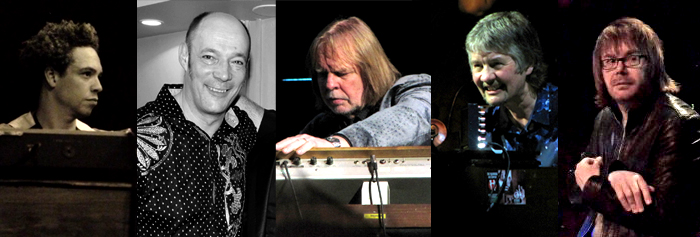
– So I became yet another person to replace just one aspect of Jon, and in the end, it was amazing how many musicians it took to stand in for Jon Lord!
The number of keyboard players was staggering – but it seems spreading out the parts was the only logical way to dilute the idea that one or two players would play tribute to Jon. It refocused everyone on the music rather than the player.
– Yes. This happened by luck and also by necessity. There’d be no other way to cover all the overdubs on something like Burn, for instance. But you’re right, it was about the music first and foremost.
– I think we hit a good balance. In a situation like this, it is dangerous to overcrowd the stage with too many people, but I think we exploited the opportunity for luxury casting without going too far overboard.
– Each performer brought something special to the concert, with their own individual playing styles, but everything was in the service of the music. Which is of course how it should always be in any case.
As an aside, I noticed a somewhat louder voice of recognition from the audience awarded to Neil Murray being announced.
– Yes… It was nice. It was one of the best things about the concert for me, getting to work with such people. And one thing I immediately noticed about Neil is that he has an attention to detail that I appreciate very much.

Let’s talk about all the orchestral arrangements for this concert. Since Jon passed, you’ve been editing his scores for publication. How did you approach the task of getting everything ready for Celebrating Jon Lord?

– Once the show started to take shape, I knew there’d be no way I’d have enough time to do everything on my own. Richard Whilds is an old friend, and much in-demand as an arranger, having done major albums recently for Sony artists such as Vittorio Grigolo. He was my first choice to help us out, and he took care of the Mk. 3 and Paice Ashton Lord songs.
– Richard is the perfect person for this – he knows and loves the music, but also has a composer’s imagination, which gives him a special edge.
– I should also acknowledge with much gratitude here the help we received from Steve Bentley-Klein on Hush, and from Nigel Hopkins and Ben Robbins on All Those Years Ago. All of these gentlemen delivered important musical parts for the concert.
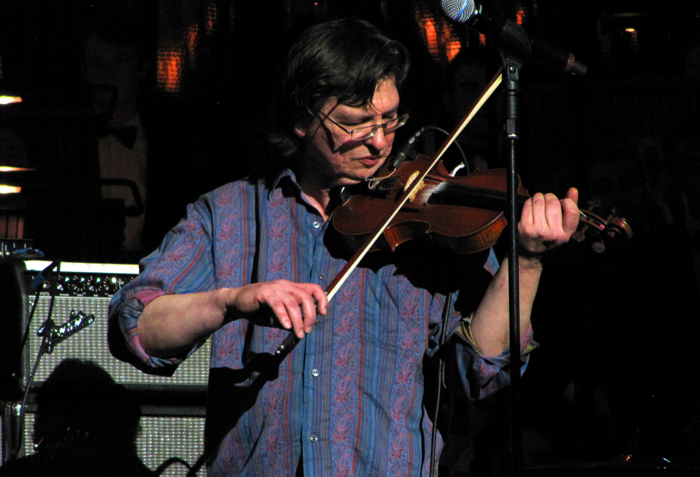
– As for my own scores, they fell into two categories: the editions of Jon’s own music and his own orchestrations, all of which were newly prepared and engraved as part of the ongoing edition – and the ones I did from scratch – most of the Purple set, and the rest of Jon’s songs.
– One thing I was pleased about, was that after all the work, in rehearsal we discovered only a couple of minor mistakes in the orchestra parts: wrong notes in Pictured Within, and in the Durham Concerto. On one of Jon’s albums I’m given a credit for “warm-hearted pedantry”, and I’m happy to say that this quality seems to be alive and well, even in his absence.
You mentioned the complexity of Burn. How did the rehearsals go for this?
– It was a blast. The brilliant arrangement by Richard Whilds was a veritable minefield of orchestral virtuosity. We spent some time on the orchestra-only day working on that, and then Glenn came in on the Thursday and just blew us away. I had feared that the complexity of the arrangement might have held us up, but it didn’t at all. On the contrary – it really helped us fly.

– Studying Burn from a performance point of view also revealed what an amazing song it is – structurally, it’s very subtle, with lots of uneven phrase lengths, clever twists and turns that go by dazzlingly quickly. In spite of having listened to it all my life, I hadn’t fully appreciated it before. I’m sure that the hand of Jon is strongly present in the subtle structuring of that song.
How did Ian Paice take to the Mk. 3 stuff – indeed all the Purple stuff that you or the rest of the group were suggesting?
– Purple’s set was agreed quite early on. Concerning Mk. 3, I think Ian is still occasionally playing some of those songs in his outings with tribute bands. He is always a very easy person with whom to discuss things. We talked about Wring That Neck, in the same version that was done in 1999, but that went in favour of Lazy, which was perhaps more of a Jon song.
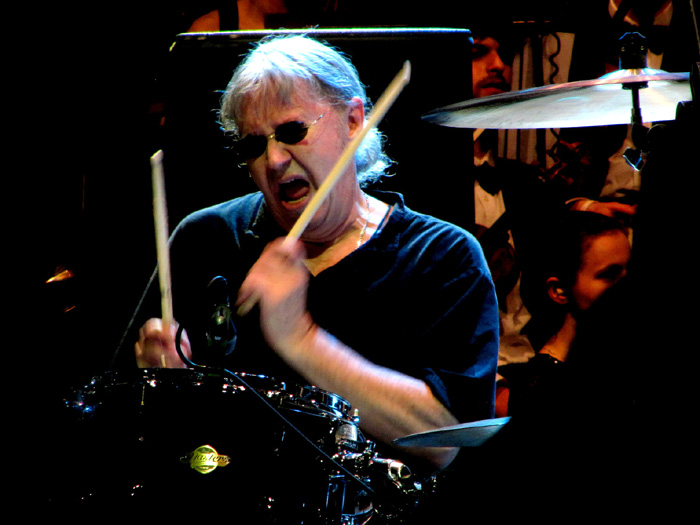
– Ian is someone I respect and trust very much. His lightness of touch with things hides a very shrewd judgement. For instance, we’d had an orchestration done on Silas & Jerome, but the idea didn’t feel right to him, and it turned out he was 100% right.
If we move on to the week of the concert, which was on Friday April 4, can you elaborate on the whole rehearsals set up?
– The way rehearsals worked was this: on the Tuesday before the concert, the house band had its first rehearsal at John Henry‘s in London. I was there, to do whatever I could to help, especially with the Sarabande tracks, and I did my old trick of trying to imitate the orchestra on the piano while the band worked on their parts.
– Then on the Wednesday, I went over to St. Mary’s Church, close to Baker Street, which was our venue for the orchestra rehearsals. The first day was the orchestra alone, while the band continued to work at John Henry’s, and on Thursday, everyone came together at St. Mary’s to get everything ready for the dress rehearsal in the Albert Hall on the Friday afternoon.
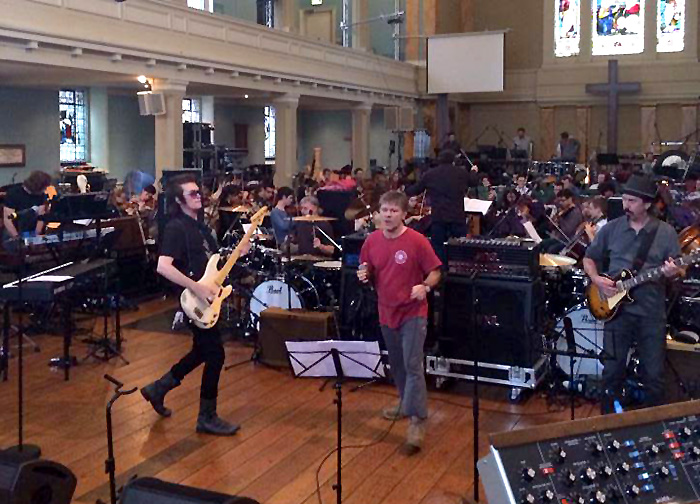
– Rehearsal time was at a premium, and we used every last moment of it. In fact, orchestra time ran out at the Albert Hall on the concert day, and I was at the piano imitating the orchestra again about 30 minutes before the doors opened while we fixed the structure of Hush with the band and guests. My only rehearsal with Jeremy Irons was a quick run-through at 6pm, just before the concert. So it was all very tight. But we made it.
– When we did the 1999 Concerto, we were lucky because we had the Albert Hall the day before the concert as well. No such luxuries this time!
So in reality, with everybody together in the same room, you had just the Thursday and Friday afternoon? This sounds very condensed.
– On the Thursday we had 6 hours, 2 sessions of 3 hours each, with band and orchestra. The Sunflower Jam office helped schedule this time very tightly to make sure that everyone was called when they were needed, and no one was kept needlessly waiting.
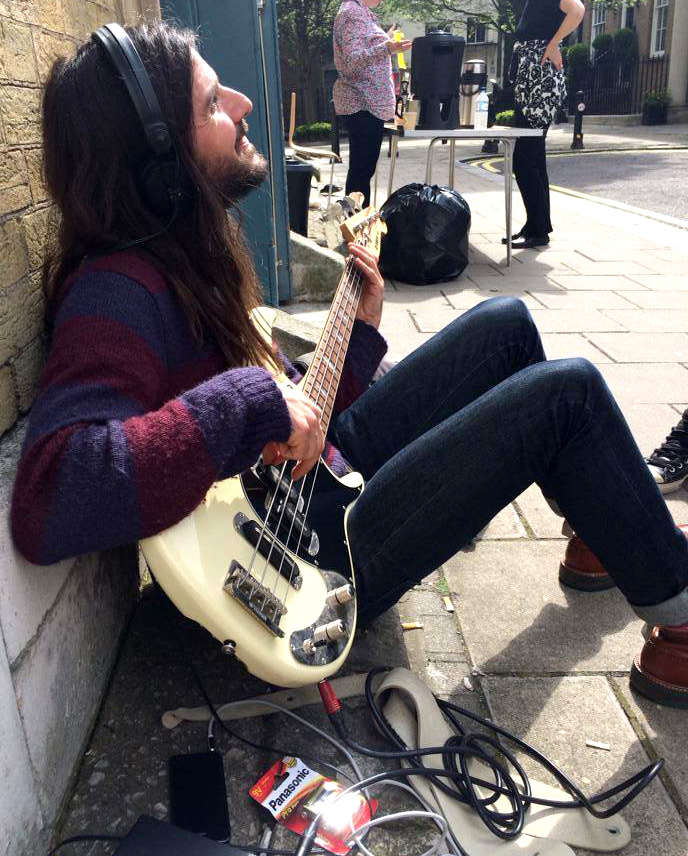
– I also had 6 hours with the orchestra alone on the Wednesday. The standard length for orchestral dress rehearsals is 3 hours, but there was never any way we’d get through it in that time, so we got special dispensation from the orchestra to extend this to 4 hours.
– The main thing about the rehearsals was to make a plan and then stick to it. Thankfully, with some magnificent support from everyone concerned, it worked. This was another aspect of the operation where the incredible amount of work put in by the Sunflower Jam office really paid off.

The technical aspect is also interesting because of the historic difficulties in miking-up and mixing the orchestra together with the band. Did the sound engineers begin preparing for this already during rehearsals at St. Mary’s?
– Yes. It was difficult in the Thursday rehearsal for everyone to be able to tell exactly how it would be, because although all the equipment and sound personnel were all in attendance, it wasn’t possible to amplify the orchestra there.
– That everything worked so smoothly is a massive tribute to a tireless and brilliant technical crew who had to do a complicated get-in at St. Mary’s for the Thursday rehearsal, and then take everything over to the Albert Hall for a very early get-in on the Friday to have everything ready in turn for a 1.30pm rehearsal start.
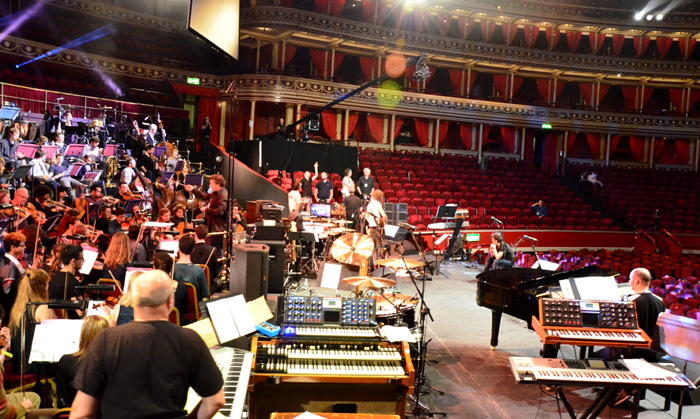
– The technical challenges of a show like this are huge: 85 musicians in the orchestra, plus all those guests, each of whose needs concerning sound and other issues needed to be taken into account. Amplifying an orchestra of that size and blending it with not just one but several different types of rock band presents special problems, even though the technology for this is now extremely sophisticated. It still requires people with great skills and an understanding of both worlds to make it all come together – from the FOH engineer Gert Sanner to production manager Andrew Thornton and everyone inbetween.
– We had different people each with special responsibilities – one person for example whose job it was to know that at a certain point he needed to highlight a cello solo, or a clarinet solo, or whatever. I also had an excellent assistant, Ellie Verkerk, who did a magnificent job reading the scores and directing the cameras during the concert, making sure that each of the ten cameras was getting the right shots.
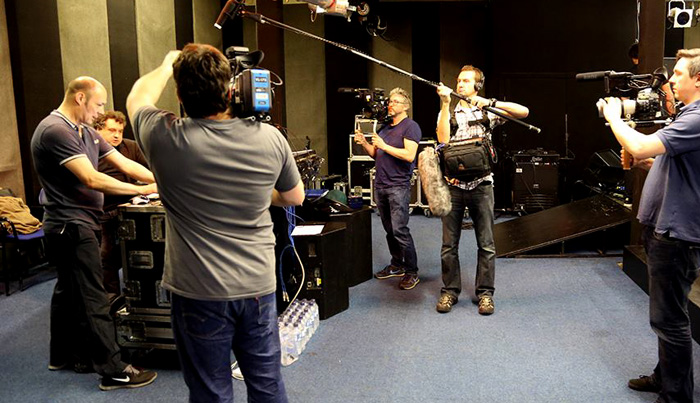
– We also had the Sunflower Jam documentary film crew following us the whole time, so the whole “making of” story will be told in a film to be issued with the live concert. Between rehearsals we all did “how’s it going” interviews, and suchlike.

– On the afternoon of the concert, the director of the concert film Tim Sidwell asked what my normal pre-concert routine was and whether I would object to having the direct lead-up to going onstage filmed. Normally I’m bad company before concerts – not so much because I get nervous as extremely impatient to get on with it. So this was a good way to pass what little spare time there was between the end of the rehearsals and going onstage.

– So 15 minutes before the concert, they were filming me pacing the corridors of the Albert Hall backstage, stick in hand, looking ‘pensive’. At one point, they put the camera on the floor and asked me to walk towards it. God knows what that shot will look like, especially since I had Mr. Wakeman just off camera doing his best to break my straight face.
– But they were a great team, and I can’t wait to see the results.
– One of my biggest regrets about the 1999 concert was the lack of reportage surrounding it. I suppose the whole thing was put together so quickly that no one had time to think of that. But there were so many stories, so many situations, so much surrounding it that is lost forever. I’m happy that we’ve avoided that this time.
On the old DVDs there’s that clip of Jon mouthing to the camera in an orchestra rehearsal somewhere: GO! A-WAY!
– Ah yes, that was taken in Argentina on the first leg of the tour in 2000 – with us eating sandwiches and the horns practicing the first movement in the background. That rehearsal, incidentally, BEGAN at 11pm, after the orchestra had already done a day’s work. I’ve never had such trouble enforcing discipline in my life.
Speaking of Purple, how did the rehearsals go this time?
– It was mostly very straightforward and efficient.
– We took a while to arrive at the correct version of When A Blind Man Cries, which was the original “long” Concerto tour version, with both a Hammond and a guitar solo. I think they have recently been playing a shorter version.
– But as always it is a joy and such a privilege to make music with them.
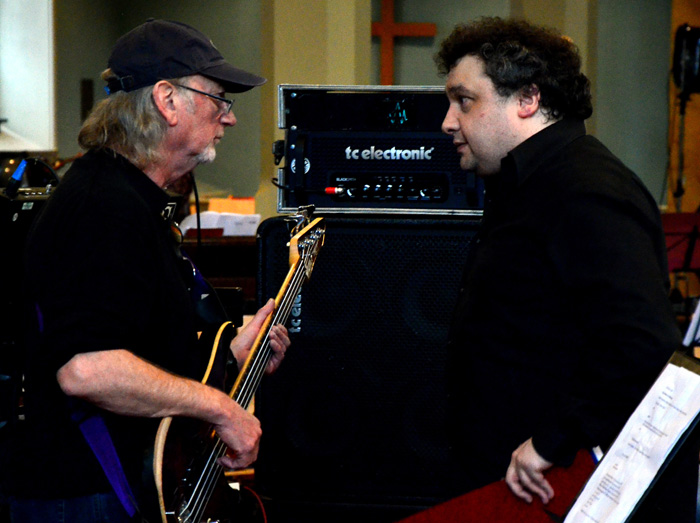
– One of the things that always impressed the orchestras we toured with then was the band’s skill as improvisers. Mia Sfura, my fiancée, who as you know played in the Romanian orchestra on the Concerto tour, and who was in the second violins of the Orion orchestra for the concert this year, always says how impressed she was that after thirty performances then they were still finding something different to play every night.
– Multiply that by the thousands of performances they’ve done of most of their repertoire and you get an idea how exceptional that aspect of what they do really is. Of course it was one of the most important aspects of Jon’s genius, and Don carries that mantle in his own brilliant and unique way.
– This is something which used to be part of every classical musician’s training. Bach, Mozart, and Beethoven were all extraordinary improvisers, and every performer of their music was expected to be able to improvise, for example, the concerto cadenzas. But the skill of the creative and re-creative have become largely separated from one another in modern classical musicians, much to their detriment, I think. Another thing we can learn about from rock musicians!
Don’t miss out
This interview runs in three parts. Coming up, Paul Mann discusses the pieces performed at Celebrating Jon Lord from a musical, orchestral and compositional point of view.
Sign up for our automated news mail (on the right) and follow us on Twitter and Facebook.
Read more:
How we celebrated Jon Lord – full setlist and artist credits.

Great read. Looking forward to the rest
Fantastic insight, can’t wait for the next instalment ! 🙂
Marvellous – a great way to recall such a wonderful night in memory of such a wonderful man. Can’t wait for the DVD. I do hope that the recording will be of all the items on the programme – it all worked so beautifully and although I loved Purple and Glenn, the classical first half was stunning.
Excellent!! Thanks Paul.
Wonderful insight and can’t wait for the rest – or the DVD of the night!
steve and i had a fantastic night it was our second sunflowerjam we cannot wait until sep 2015 for the next one heres hoping it is at the fabulous royal albert hall thankyou sunflowerjam juliex
Thannk you for sharing